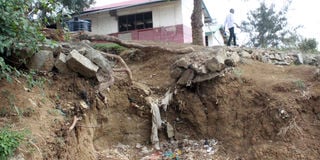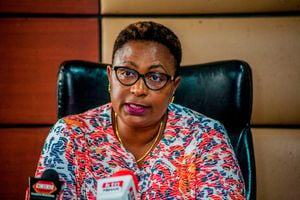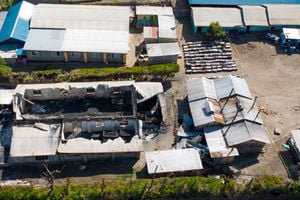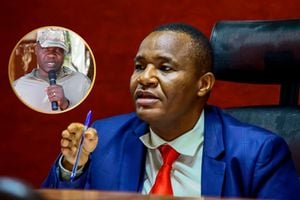School at risk as soil erosion threatens to bring down classrooms

A huge gully occasioned by soil erosion next to classrooms at Kwa Jomvu Primary School in Mombasa.
What you need to know:
- Soil erosion is clearly moving fast towards the rest of the school compound.
- Land belonging to the learning institution has been depleted by soil erosion.
For a first time visitor to Kwa Jomvu Primary School at Jomvu Sub-county in Mombasa, the large playing ground surrounded by classrooms and administrations blocks would seem typical of many old public schools across the country.
This depiction changes suddenly as one moves behind a section of buildings, where an impending environmental disaster which is threatening the existence of the school is evident.
A huge gully full of shrubs lies behind these buildings and the soil erosion is clearly moving fast towards the rest of the school compound. It has reached just a few feet from one of the buildings.
Since the establishment of the school in 1963, soil erosion has been depleting land belonging to the learning institution, tearing away more than two acres of land so far.

A huge gully occasioned by soil erosion behind classrooms at Kwa Jomvu Primary School in Mombasa.
A recent visit to the area by Nation.africa revealed a dire situation of negative environmental, societal and economic impact, resulting from the denudation of soil.
The cracks on the walls, some recently renovated as well as the erection of slabs around the classrooms show the true picture of how the erosion has been affecting the school and the struggles by the administration to curb a disaster.
The school headteacher Ms Everlyne Obondo confirms that the situation worsens during the rainy seasons, at times washing away part of the school infrastructure including classrooms.
"If this continues then there's part of the school which might disappear. The erosion has destroyed several parts of the school and is also not safe for the pupils," she said.
Read:'I am devastated': Man recounts horror of Baringo landslide that killed wife, two sons, and nephew
The erosion has left behind large gullies worsened by mass movement of running water during heavy rains.
In some areas, the gullies are sunk so deep, posing danger to the school which has a population of 2,084 pupils. It is the only public primary school in the area.
As for now, some of the buildings at risk are not being used so as to prevent any tragedy. The pupils have been accommodated in the available spaces in that, nursery pupils share two streams, Grades 1-4 two streams each, Grades 5-6, three streams each with those in Grades 7 and 8 sharing the only two available streams.
According to the school administrators, the affected area would have expanded the sporting ground or for the pupils or even facilitate the expansion of the school to allow for the smooth transition to the competency-based curriculum.

A huge gully occasioned by soil erosion next to classrooms at Kwa Jomvu Primary School in Mombasa.
The effects of soil erosion has also gone beyond the loss of fertile land. Loose soils which are rich in nutrients have been washed away therefore disallowing agricultural activities in the school.
"We have a high enrollment in the school and at the moment we are thinking of constructing more classrooms. We need the classes, a kitchen, playgrounds, and even a dispensary to treat our pupils among other amenities, but we're currently limited because of unsuitable land because of the erosion,” added the headteacher.
Mr Suleiman Hassan, a resident from the area, says he joined the school in 1979 until 1994 when he completed his primary education. He says the erosion worsened when El Nino rains pounded the region in the year 2000.
"We used to play in these grounds when we were young because I remember our seniors used separate fields from pupils in lower classes, so we used to come here. My fear now is if the heavy rains continue coming then we might lose the school," said Mr Hassan.
Some interventions have been put in place led by the office of the National Government Constituencies Development Fund (NG-CDF) in Jomvu but have not borne fruit.
In 2019, they constructed gabions to combat further erosion but nature has fought back, and the flood waters have washed away some of the gabions.
Ms Asma Mohammed, an official from the Jomvu NG-CDF offices confirmed that the land degradation as a result of the erosion has also affected the nearby Jomvu Girls Secondary School, the only public girls' school within the constituency.
"NG-CDF cannot fund reclaiming of the land unless we use all the money from the financial year to do the backfilling. So we are calling on the national government to chip in and save this school," she said.

Kwa Jomvu Primary School at Jomvu Sub-county in Mombasa.
According to experts from the Geological Society of Kenya (GSK) the soil type in the area is prone to erosion because of its structural nature which is composed of a limestone layer with sandy layers of soil at the bottom.
The loose soils described as fine grains have made it possible for the erosion to occur.
The geological experts proposed construction of underground water channels flowing into the ocean, calling for urgent intervention in order to address the matter.
The school management is also appealing to the ministry of environment to visit the area, recommending backfilling to be done to reclaim the affected part and save the institution from suffering the brunt of Mother Nature.





